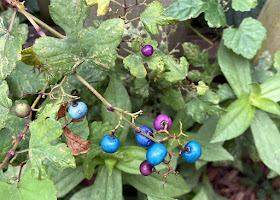Today I’ve been thinking a lot about birds.
I see them feeding outside my window. A downy woodpecker pecking on the suet cake, stopped and tilted its head my way – as if listening to me play my guitar. The pretty little finches make me smile to see their energy and free spirit. The male cardinals chase each other through the shrub border. A mockingbird bathes in our partially open garden pond. A pair of bluebirds stop for a drink on their way through. Chickadees, nuthatches, and titmice flit from feeder to pergola to shrub in their nervous way.On a drive today we saw eagles, swans, and crows. Flocks of geese adorned the blue sky of puffy clouds. Eagles sat on Emiquon’s ice waiting for a meal. Swans ate corn left by a combine in the field. Crows jumped around along the roadside.
While drinking our morning coffee in the hot tub, I watched a blue jay fly from tree to tree. Its loud “caw” making it easy to find. Flickers hunkered down in the holes of dead pines in our woods. Woodpeckers bobbed up and down as they fly overhead.
Birds seem to be an important part of my life and home. My living room is decorated with birds of many types in figures and wall pictures. My last watercolor painting featured a cardinal on a limb.
My most recent project is to create a quilt for our bedroom that matches a beautiful hummingbird painting that we bought while vacationing in Ecuador. It features two blue hummingbirds on a nest set in a jungle tree. My new quilt is various shades of blues and white. I made two throw pillows to match, each with a bird silhouette formed of fabric squares. I'll post a picture of the final result on my RetroRhondaJ Facebook Page.
In many ways, my outdoor gardens are created with birds in mind. Of course, we have bird feeding stations outside our living room and office windows, but there are also landscape plants and features that bring birds to our yard. My landscape provides food, shelter, water, and nesting sites for birds living her year-round and migrating through in spring and fall. Read my article on “Creating a Backyard Bird Habitat” to learn more.
This year I noticed a cardinal plucking the seeds of my lilac bush. Birds often eat crabapples, juniper berries, and other plant parts in our yard. Like humans, birds have favorite foods and those are the ones we try to feed them. Read my article on how to “Grow Your Own Bird Food” to learn the plants that common bird seed comes from.
I’ve had friends ask how we get so many birds in our yard. My friend who works for Illinois Audubon showed us tricks over the years. These include using good quality food and providing feeding stations for various types of birds. For example, some are ground feeders, while others prefer stationary platforms. Read my article on “Bird Feeding Basics” for more details.
Finally, as a retiree I spend hours (it seems) each day watching birds in our backyard or during our travels. A good pair of binoculars and a spotting scope help enhance the experience. Read my article on “BirdingEquipment…how to use binoculars” to be sure your equipment is setup for your best experience.
Wow, birds really bring me a lot of pleasure. I think I’ll get a cup of tea and go watch some more birds outside the windows. You can “watch” them with me in my RetroRhondaJ Facebook Page photo album of Backyard Birds.
Happy Birding!


























